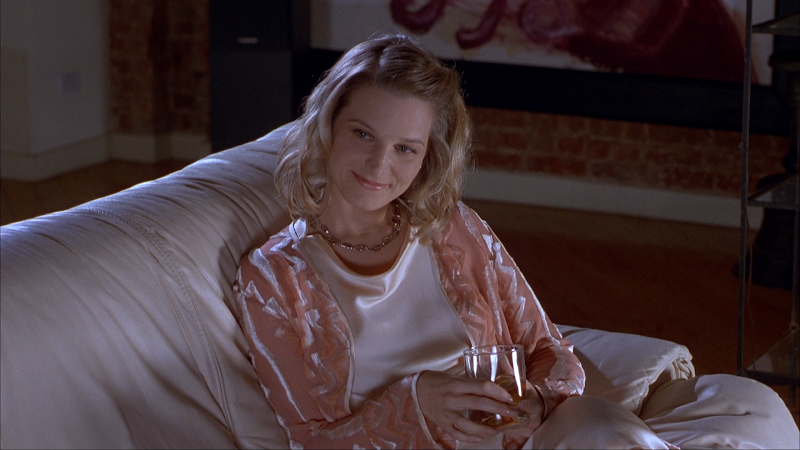But it was also... kinda good? There are some surprising production values on display, especially in the first third, which is packed with military vehicles, crowds and a set piece involving a church bombing. I think the lead actor is interacting with real soldiers during the course of their actual duties in a few shots. The film is set in Belfast during the "troubles," which gives a powerful backdrop to what ultimately becomes a very personal, intimate story. The film, like many multinational productions, is dubbed; but despite that, some very sincere, powerful performances come across. One of the women plays her naivete a little broadly (she comes across mentally challenged, but I think she's just supposed to be the picture of pure innocence) and a few of the accents feel phony. But most of the actors really seem to be digging deep, and Matthieu Carriere (Malpertuis, The Aviator's Wife) actually proves a riveting match for Hess's presence. And that fact that this is all based (surprisingly closely, as it turns out) on the true crime mass murders by Richard Speck gives this film a dramatic weight similar exploitation films lack.
Not to over-praise the film. It's still got its problems. There's this whole subplot about a budding lesbian affair which dovetails into an extended, over-the-top group rape scene that feels entirely like the product of the male filmmakers' horndog impulses rather than anything true or meaningful stemming from the characters. Like Cannibal Holocaust or numerous other films with a strong message condemning what it simultaneously indulges in, this film wants to be better than its trashy peers while also out-trashing them. It often succeeds, but that does somewhat depend on how much you're willing to overlook a few double-standards.
 |
| A scene only in the complete Born for Hell cut. |
And, for those curious, Severin has also included the Naked Massacre cut, fully restored as well, on their new blu.
 |
| 1) 2005 Mill Creek DVD; 2) 2021 Severin BD (BFH); 3) 2021 Severin BD (NM). |
Severin comes through in the audio department, too, giving us the option of either the English or French track (both are dubs, so take your pick) in lossless DTS-HD, with optional English subtitles. Their Naked Massacre cut just has the English with no subs. Mill Creek, of course, just has the one English dub with no subtitle options, and it's a thinner, noisier mix at that.
And this is a special edition! Again, I never thought I'd see this film receive this level of treatment. We get some good stuff, too. Some good stuff and some weird, additional stuff that starts to feel like excessive padding. But let's start with the strongest: a new on-camera interview with Carriere. He has some interesting memories, although not a ton, so it's padded out with some general overview of his whole career. But it's all good, and no Naked Massacre fan will want to miss it. Then there's a great talk with true crime podcaster Esther Ludlow who gives a roughly 40 minute history on the entire Richard Speck case, from his childhood to his trial, which is both fascinating in its own right, but also reveals that this film was more faithful to the real story than one might expect, given the changes they also made. Plus, they found the Italian-language trailer (with optional subs). Oh, and there's a nice Criterion-style video essay on the back story of the film, including a nice section comparing the film locations as they look today. These are all great and should not be missed.
There's also more stuff on this disc, which at least adds some curiosity value, that you may or may not choose to peruse depending how much extra time you've got to spend. There's a featurette editing together interviews with John McNaughton (Henry: Portrait Of a Serial Killer) and Gary Sherman (Dead & Buried), two directors who had nothing to do with this movie, but have some vague memories of the Speck murders. Not that they were involved or anything, but you know, they saw it on the news. Then, there are two interviews with a painter named Joe Coleman, who's obsessed with Speck. That's him, above, sitting in front of one of the two wax sculptures he owns of Speck. He has a rare photograph of Speck which he can't show us, because it's too "holy," but does let the producer of the featurette see ("that is Richard Speck," she confirms for us). He's a goofball who seems to think the murders had to happen, and are sort of justified, for some unexplained cosmic reason that's loosely connected to Richard Nixon. But the real problem with all three of these featurettes is that they retell all the same events of the Speck murders that were already covered better and in more detail in the Ludlow clip. So it's mostly just painful repetition. There are some interesting tidbits to be picked out if you have the patience to sift through it all - McNaughton has an interesting connection to the Speck story and Joe shows us one of the paintings Speck made in prison. But it's chiefly mind-numbing filler, and most viewers will be best served just sticking to the stuff in my previous paragraph.
So obviously this film isn't for everybody. Don't screen it at your baby shower. But restored as Born for Hell, Naked Massacre actually proves to be deserving of a broader audience than ever before. It still serves up the sleaze for everyone who's craving that - and now in HD - but it's also a credible dramatic, if imperfect, piece of art. Give it a go if you're feeling brave.
























































